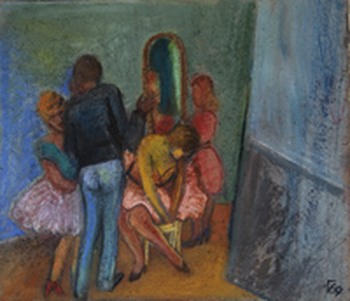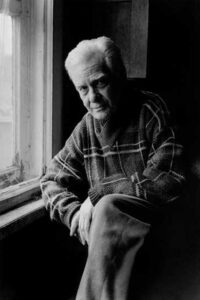🗓️Friday, April 22
6:30pm -10:00pm
FRANTS GALLERY SPACE
📍81 Wooster St, 4th fl, New York, NY 10012 USA
RSVP📧 rsvp@frantsgallery.com
Frants Gallery Space, St. Petersburg Arts Project
cordially invite you to attend
Self-Portrait in Time
an exhibition by
-VALENTIN GROMOV-
Valentin Gromov: Intersections in Space
Alexander Arefiev (1931–1978), Richard Vasmi (1929–1998), Valentin Gromov (b. 1930), Vladimir Shagin (1922–1999), Sholom Schwartz (1929–1995) – a circle of friends: adolescents in the forties, young adults in the fifties. They laid foundation to the independent art in Leningrad and created their own style of painting. I will venture to draw a parallel between them and the group Bay Area that emerged in California at the same time. Both groups were painters; both turned to the real world, the Californians – from the Abstract Expressionism, a national treasure of America; the Leningradians – from the Social Realism, an asset of the Superpower, which, in a certain sense of the word, was also an abstraction. In the latter case, it was a great deal more daring, and the painting of the Leningradians is distinguished by being more intense, passionate and specific. Because painting for them was much like literature for Osip Mandelstam: “stolen air”. The Californians were more academic, they were painting a posing model; the Arefievans (as they were called after their leader) – were literally chasing nature, spying on it in their attempts to capture the living life unawares. The Californians were, after all, respectable people and professors of art academies; ours were mavericks who were practically never allowed in the universities, even as students. Gromov was the only one of them who managed to receive a higher education – he graduated from the correspondence department of a polygraph institute, majoring in the printed graphics. You can judge how good a student he was by his etchings. He still makes them with the enthusiasm and technical excellence that are accessible to but a few nowadays.

From the Series “Mirrors” Pastels, Paper. 40×50 cm. 1969
In Gromov’s paintings, one could point out the characteristics that are common to the entire group: first and foremost, the importance of a subject matter and its specificity. And, from the point of view of form, it is the intensity of color. The stylizing of figures, which was an important feature with his friends, emerged in his work just barely in the fifties in the series “Lobby” and “Mirrors”. There is a hardly noticeable geometrization – the curvilinear one, it structures the space of a landscape and highlights the borders of various sections. However, if we are to speak about the characteristics that are fundamentally Gromov’s, that will be his interest in space, in the fractured compound composition, in the accidental intersection of figures and objects. Also, in Gromov’s works, there is a coexistence of the light, iridescent colors and somber ones and of the wretched and festive principles in life.
In “Lobby” and “Mirrors”, the abovementioned series that spill into each other, against the background of pitiful scuffed walls of the clubs – Soviet dancing-halls – girls are prettying themselves, all dressed-up for the only possible feast in their life. Satire, the caricature nature of characters and a sensation of the feast are simultaneous. The feast that creates the flowering of life. The flowering in the literal sense is, in fact, a frequent motif in Gromov’s works: trees in blossom or bunches of thistles in bloom that attracted Gromov by the fact that the rampage of colors suddenly emerges from a gray and unsightly substance.
In Gromov’s crowds of people, each figure is usually absolutely independent. The variety of disconnected figures, their positions and poses are what the beaches of Gromov amount to. The accidental intersection of a child and a dog in the street, which lasts for just a split second, becomes a motif of his work. Many components, independent in their meaning, comprise Gromov’s landscape – wide-open and dynamic. The dynamics is created by the character of lines and the predominance of diagonals; at times, it is intensified by the presence of a moving mechanism – a train or a tram. The landscape is always specific: in the fifties, it is Rzhevka, the hilly outskirts of the city where one glance is capable of encompassing a multitude of dissimilar parts; later, it is Staritsa in the Tver Province where he spends his summers nowadays. Over there, once again, he frequently opts for the clearly defined quilted space: gardens. In the later years, there are compositions with the closed space: courtyards on the Petrogradskaya Storona where he grew up; courtyards and lanes of the Vassilievsky Island where he currently lives. In the theme of Theater and, later, Fashion, there is a special space within the space – a stage or a podium – with a female figure that has placed herself on display.
In the last decade, Gromov, freed from the necessity to go to work, is at his most productive. When, after losing his friends and brothers-in-arms, he is left alone, his paintings show an intensification of the original gravitation towards the old masters and to the eternal, up to the biblical, themes. There are fantasies on the subject of nude or seminude female figures. They are volumetric, often at a complex angle and sometimes in movement. The intensification of color, the coupling of draughtsmanship and sketchiness in the same work and the broken inking point out to the time when they were created. The vision of a female body and its treatment as a magnificent mystery refer to the old masters. And yet another contrast emerges: eternity and modernity.
L. Gurevich
